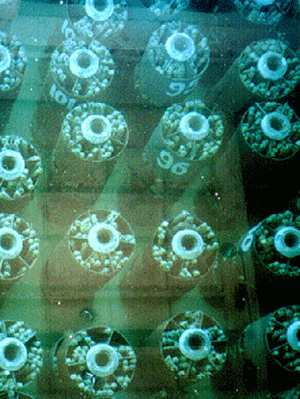 Spent fuel fire on U.S. soil could dwarf impact of Fukushima, Science, By Richard Stone May. 24, 2016 A fire from spent fuel stored at a U.S. nuclear power plant could have catastrophic consequences, according to new simulations of such an event.
Spent fuel fire on U.S. soil could dwarf impact of Fukushima, Science, By Richard Stone May. 24, 2016 A fire from spent fuel stored at a U.S. nuclear power plant could have catastrophic consequences, according to new simulations of such an event.
A major fire “could dwarf the horrific consequences of the Fukushima accident,” says Edwin Lyman, a physicist at the Union of Concerned Scientists, a nonprofit in Washington, D.C. “We’re talking about trillion-dollar consequences,” says Frank von Hippel, a nuclear security expert at Princeton University, who teamed with Princeton’s Michael Schoeppner on the modeling exercise.
The revelations come on the heels of a report last week from the U.S. National Academies of Sciences, Engineering, and Medicine on the aftermath of the 11 March 2011 earthquake and tsunami in northern Japan. The report details how a spent fuel fire at the Fukushima Daiichi Nuclear Power Plant that was crippled by the twin disasters could have released far more radioactivity into the environment.
The nuclear fuel in three of the plant’s six reactors melted down and released radioactive plumes that contaminated land downwind. Japan declared 1100 square kilometers uninhabitable and relocated 88,000 people. (Almost as many left voluntarily.) After the meltdowns, officials feared that spent fuel stored in pools in the reactor halls would catch fire and send radioactive smoke across a much wider swath of eastern Japan, including Tokyo. By a stroke of luck, that did not happen.
But the national academies’s report warns that spent fuel accumulating at U.S. nuclear plants is also vulnerable. After fuel is removed from a reactor core, the radioactive fission products continue to decay, generating heat. All nuclear power plants store the fuel onsite at the bottom of deep pools for at least 4 years while it slowly cools. To keep it safe, the academies report recommends that the U.S. Nuclear Regulatory Commission (NRC) and nuclear plant operators beef up systems for monitoring the pools and topping up water levels in case a facility is damaged. The panel also says plants should be ready to tighten security after a disaster.
At most U.S. nuclear plants, spent fuel is densely packed in pools, heightening the fire risk. NRC has estimated that a major fire at the spent fuel pool at the Peach Bottom nuclear power plant in Pennsylvania would displace an estimated 3.46 million people from 31,000 square kilometers of contaminated land, an area larger than New Jersey. But Von Hippel and Schoeppner think that NRC has grossly underestimated the scale and societal costs of such a fire…….http://www.sciencemag.org/news/2016/05/spent-fuel-fire-us-soil-could-dwarf-impact-fukushima